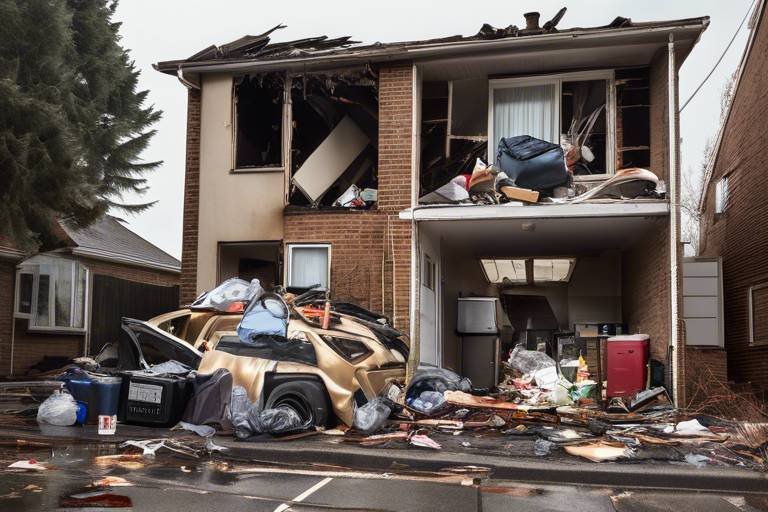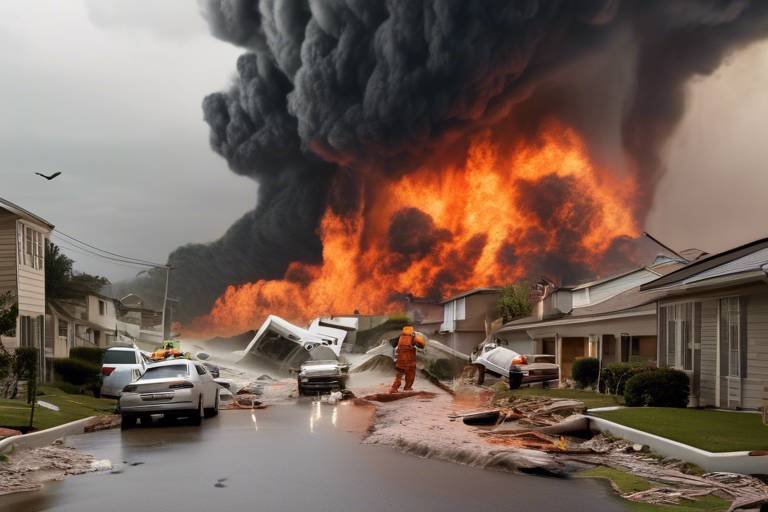Responsibility of Landlords in Emergency Preparedness
In today's unpredictable world, the responsibility of landlords goes beyond just collecting rent and maintaining properties. They play a crucial role in ensuring the safety and preparedness of their tenants during emergencies. Imagine being in a situation where a natural disaster strikes, and you are left scrambling for information and resources. This is where the proactive measures of a landlord can make all the difference. From understanding legal obligations to creating comprehensive emergency preparedness plans, landlords must take the initiative to protect their tenants and their properties.
Landlords are not just property owners; they are guardians of safety. Their responsibilities encompass a range of duties that can significantly impact the well-being of their tenants. In this article, we will delve into the essential roles landlords must embrace to ensure a secure living environment. Whether it’s formulating an emergency response plan or fostering tenant involvement, every action taken can lead to a more prepared community. So, let’s explore what landlords need to know and do to become champions of emergency preparedness.
First and foremost, landlords must be well-versed in their legal obligations concerning emergency preparedness. Local and federal laws outline specific responsibilities that landlords have towards their tenants during crises. For instance, many jurisdictions require landlords to provide safe housing, which includes ensuring that properties are equipped with necessary safety features, such as smoke detectors and fire extinguishers. Failure to comply with these regulations can lead to legal repercussions and jeopardize tenant safety.
Additionally, landlords should stay informed about updates to safety regulations and emergency response protocols. This awareness not only protects tenants but also shields landlords from potential liabilities. By understanding the legal landscape, landlords can create a solid foundation for their emergency preparedness plans.
Creating a comprehensive emergency preparedness plan is crucial for landlords. This plan should outline the steps to be taken in various emergency situations, such as fires, floods, or severe weather events. Key components of an effective plan include:
- Identifying potential hazards specific to the property and location.
- Establishing evacuation routes and procedures.
- Providing emergency contact information for local services.
- Designating safe areas within the property.
By addressing these elements, landlords can ensure that tenants have clear guidance on what to do in an emergency, reducing panic and confusion when it matters most.
Conducting a risk assessment is a vital step in developing effective management strategies for emergencies. Landlords should evaluate their properties for potential hazards, such as faulty wiring, inadequate drainage systems, or structural weaknesses. Understanding these risks allows landlords to implement necessary improvements and prepare for emergencies more effectively.
Furthermore, risk assessments should be revisited regularly, particularly after significant weather events or changes in local infrastructure. This ongoing evaluation helps maintain a high level of preparedness and ensures that tenants are not caught off guard.
Providing training and resources to tenants is essential for fostering a culture of preparedness. Landlords should consider organizing workshops that cover topics like fire safety, first aid, and emergency response. By equipping tenants with knowledge and skills, landlords empower them to act confidently in times of crisis.
Additionally, landlords can create resource guides that outline emergency procedures, contact numbers, and local emergency services. These guides can be distributed in printed form or made accessible online, ensuring that tenants have the information they need at their fingertips.
Conducting regular emergency drills and reviews is another way to keep preparedness plans fresh in tenants' minds. Just like fire drills in schools, practicing emergency procedures helps reinforce the steps tenants need to take during actual emergencies. These drills can be scheduled quarterly or biannually, allowing landlords to assess the effectiveness of their plans and make necessary adjustments.
Moreover, after each drill, landlords should gather feedback from tenants to identify areas for improvement. This iterative process ensures that preparedness plans evolve based on real experiences and concerns.
Effective communication is key during emergencies. Landlords must establish clear channels of communication with their tenants to ensure timely information dissemination. This could include setting up group messaging apps, email alerts, or even a dedicated emergency hotline. By having a reliable communication strategy in place, landlords can keep tenants informed about ongoing situations, evacuation orders, or safety measures.
Additionally, it's important for landlords to be approachable and open to questions. Tenants should feel comfortable reaching out for clarification or assistance, especially during stressful situations. Building this rapport can foster a sense of community and trust.
Encouraging tenant involvement in emergency preparedness fosters a sense of community and shared responsibility. Landlords can engage tenants by hosting preparedness workshops or community meetings to discuss emergency plans. This involvement not only educates tenants but also builds camaraderie, making everyone more invested in the safety of their living environment.
Implementing feedback mechanisms allows tenants to voice their concerns and suggestions. Landlords can create anonymous surveys or suggestion boxes that encourage tenants to share their thoughts on emergency preparedness efforts. This feedback is invaluable for improving plans and ensuring that they meet the needs of the community.
Finally, landlords can enhance preparedness by collaborating with local organizations. Partnering with community resources, such as fire departments or emergency management agencies, can provide landlords and tenants with additional training, resources, and support. These collaborations can also lead to community-wide initiatives that strengthen overall emergency readiness.
Q: What are the legal responsibilities of landlords during emergencies?
A: Landlords are required to provide safe housing, which includes maintaining safety features and complying with local regulations regarding emergency preparedness.
Q: How can landlords involve tenants in emergency preparedness?
A: Landlords can involve tenants by hosting workshops, conducting drills, and encouraging feedback on emergency plans.
Q: What should be included in an emergency preparedness plan?
A: An effective plan should include hazard identification, evacuation procedures, emergency contact information, and designated safe areas.

Understanding Legal Obligations
When it comes to emergency preparedness, landlords have a critical role to play, not just for their own peace of mind but also for the safety of their tenants. Understanding the legal obligations surrounding this responsibility is essential. Various local and federal laws dictate what landlords must do to ensure their properties are safe and ready for emergencies. For instance, the Occupational Safety and Health Administration (OSHA) and local housing codes may require landlords to maintain certain safety standards and provide information on emergency procedures.
Additionally, many jurisdictions have specific regulations regarding natural disasters, such as floods, earthquakes, or hurricanes. These laws often require landlords to take preventive measures, such as installing smoke detectors, fire extinguishers, and emergency exits. Failure to comply with these regulations can lead to legal repercussions, including fines or lawsuits, which is something no landlord wants to face. It’s not just about avoiding penalties; it’s about protecting lives.
Moreover, landlords should be aware of their obligations to inform tenants about emergency procedures. This includes providing clear instructions on what to do in the event of various emergencies, such as fires, severe weather, or other crises. It's not enough to simply have a plan; landlords must ensure that their tenants are fully aware of it. This can be achieved through:
- Written notices distributed to tenants
- Regular meetings to discuss emergency protocols
- Incorporating emergency information into lease agreements
In many regions, landlords are also required to conduct regular maintenance checks to ensure that safety equipment is functioning correctly. This includes testing smoke alarms and fire extinguishers, as well as ensuring that emergency exits are accessible and clearly marked. By being proactive, landlords can not only comply with legal obligations but also foster a safer living environment for their tenants.
In summary, understanding legal obligations is not just about ticking boxes; it’s about creating a culture of safety and preparedness within rental properties. This commitment can be the difference between life and death during an emergency, making it imperative for landlords to stay informed and engaged in their responsibilities.

Emergency Preparedness Plans
Creating a comprehensive emergency preparedness plan is not just a good idea; it's essential for landlords who want to ensure the safety and well-being of their tenants. Think of it as a roadmap for navigating through the stormy seas of unexpected crises. Emergencies can strike without warning, whether it’s a natural disaster like a hurricane or a man-made situation such as a fire or a gas leak. Therefore, having a solid plan in place can mean the difference between chaos and calm.
At the heart of any effective emergency preparedness plan lies a few key components that every landlord should consider. First and foremost, it’s crucial to identify potential hazards that could impact your property and tenants. This means conducting a thorough risk assessment to pinpoint vulnerabilities. Once you have a clear understanding of the risks, you can develop strategies tailored to mitigate those dangers. For instance, if your property is located in an area prone to flooding, you might want to implement measures like installing sump pumps or creating drainage systems.
Next, communication becomes a cornerstone of your emergency preparedness plan. Landlords should establish clear and effective communication channels to keep tenants informed during a crisis. This could involve setting up a dedicated emergency contact number or using group messaging apps to disseminate information quickly. Remember, in times of distress, clarity is key. Tenants should know who to contact, what steps to follow, and where to find resources. A well-informed tenant is a safer tenant.
Additionally, landlords should consider providing training and resources to their tenants. This could include workshops on emergency response techniques, such as first aid or fire safety. Providing tenants with the knowledge and tools they need can empower them to take action when it matters most. For example, if a tenant knows how to use a fire extinguisher or how to perform CPR, they can potentially save lives in an emergency situation.
Furthermore, regular drills and reviews of the emergency preparedness plan are vital. Just like athletes practice their plays, tenants need to practice their emergency responses. Conducting drills can help everyone understand their roles and responsibilities during a crisis. It also helps to identify any gaps or weaknesses in the plan that need to be addressed. After each drill, landlords should gather feedback to improve the plan continually.
In summary, an effective emergency preparedness plan is a multifaceted approach that combines risk assessment, clear communication, tenant training, and regular practice. By investing time and effort into these areas, landlords can create a safer living environment for their tenants, ensuring that everyone is prepared when disaster strikes. Remember, preparedness is not just about having a plan; it’s about fostering a culture of safety and awareness within your community.

Risk Assessment and Management
When it comes to emergency preparedness, understanding and managing risks is fundamental for landlords. Think of risk assessment as a landlord's safety net; without it, both the property and the tenants are vulnerable to unforeseen events. By identifying potential hazards, landlords can create a robust framework for managing emergencies effectively. This proactive approach not only protects tenants but also minimizes damage to the property.
So, what does a thorough risk assessment entail? First, landlords need to conduct a comprehensive evaluation of their properties. This involves looking at various factors such as:
- Location: Is the property in a flood zone, earthquake-prone area, or susceptible to wildfires?
- Building Structure: Are there any weaknesses in the building that could exacerbate damage during an emergency?
- Utilities: How reliable are the electrical, plumbing, and gas systems in the event of an emergency?
Once these risks are identified, landlords should prioritize them based on severity and likelihood. This prioritization helps in developing effective management strategies. For instance, if a property is located in a flood zone, it would be wise to invest in flood barriers and ensure that the drainage system is functional. On the other hand, if the building has outdated electrical systems, upgrading them could prevent fire hazards.
Moreover, risk management isn't just a one-time task. It's an ongoing process that requires regular reviews and updates. Landlords should schedule periodic assessments to account for any changes in the property or surrounding environment. This could involve:
- Regular inspections of the property
- Updating emergency plans based on new risks
- Engaging with tenants to gather insights on their concerns
By fostering a culture of safety and preparedness, landlords not only enhance the security of their properties but also build trust with their tenants. After all, when tenants feel safe, they are more likely to stay long-term, which is a win-win for everyone involved. In this way, risk assessment and management become more than just legal obligations; they transform into essential components of a landlord's responsibility to create a secure living environment.

Training and Resources
When it comes to emergency preparedness, are the backbone of ensuring that tenants feel equipped to handle unexpected situations. Landlords should not only provide a roof over their tenants' heads but also empower them with the knowledge and skills needed during emergencies. Think of it as giving tenants a toolkit—one that includes everything they need to navigate through crises safely.
First off, landlords should consider organizing emergency preparedness workshops. These workshops can cover a range of topics, such as fire safety, first aid, and evacuation procedures. Imagine a scenario where a fire breaks out in the building. Tenants who have undergone training will know exactly what to do—where to find the nearest exits, how to use a fire extinguisher, and even how to assist others if necessary. This kind of preparedness can make all the difference in a high-stress situation.
Moreover, providing resource materials is equally important. Landlords can create a comprehensive emergency guide that outlines essential contacts, emergency procedures, and safety tips. This guide can be distributed in print or digitally, ensuring that tenants have easy access to vital information at their fingertips. To make it even more engaging, consider including infographics or quick reference cards that highlight key actions to take during specific emergencies.
In addition to workshops and guides, landlords should also consider offering access to online training resources. There are numerous platforms that provide courses on emergency preparedness, ranging from basic first aid to advanced survival skills. By providing tenants with access to these resources, landlords can foster a culture of safety and readiness within their properties. It’s like giving tenants a personal coach for their emergency preparedness journey!
Finally, it's crucial for landlords to establish a support network for tenants. This could involve partnering with local emergency services or community organizations that specialize in disaster preparedness. By collaborating with these entities, landlords can offer tenants additional training sessions and resources. For instance, a local fire department might conduct a fire safety seminar, or a health organization could provide first aid training. This not only enhances tenants' skills but also builds a stronger community.
In summary, the responsibility of landlords extends beyond just property management. By investing in , landlords can significantly enhance their tenants' ability to respond effectively during emergencies. It’s not just about compliance with legal obligations; it’s about fostering a safe and prepared community where everyone can thrive, even in the face of adversity.

Regular Drills and Reviews
When it comes to emergency preparedness, one of the most effective strategies landlords can implement is the practice of . Think of it as a rehearsal for a play; the more you practice, the more confident you become in your role. Just like actors need to know their lines, tenants need to be familiar with emergency procedures. Regular drills help ensure that everyone knows what to do when the unexpected happens. They create a sense of familiarity and reduce anxiety during actual emergencies.
But why stop at just conducting drills? It's equally important to review and refine the emergency plans regularly. This means sitting down with your tenants and discussing what went well during the drills and what could be improved. Feedback is invaluable. For instance, if tenants express confusion about exit routes or emergency contacts, landlords can take immediate steps to clarify these points. This collaborative approach not only enhances safety but also fosters a sense of community among tenants.
Moreover, maintaining an open line of communication is crucial. After each drill, landlords should encourage tenants to share their thoughts and experiences. This could be done through an informal meeting or even a quick survey. Here’s a simple table that outlines the key components of effective drills and reviews:
| Component | Description |
|---|---|
| Frequency | Conduct drills at least twice a year to keep preparedness fresh. |
| Involvement | Encourage tenant participation to ensure everyone is on the same page. |
| Feedback | Collect feedback after drills to identify areas for improvement. |
| Documentation | Keep records of drills and reviews for future reference and accountability. |
In addition to these practices, landlords should also consider integrating real-life scenarios into their drills. Instead of just walking through the motions, simulate situations like a fire alarm or a natural disaster. This not only makes the drill more engaging but also helps tenants to think critically about their responses. By immersing tenants in realistic scenarios, landlords can better prepare them for the chaos that often accompanies emergencies.
Lastly, remember that preparedness is not a one-and-done deal. The landscape of emergencies can change, and so should your plans. Regular reviews allow landlords to adapt to new risks or changes in the property. By committing to a culture of preparedness, landlords can significantly enhance the safety and well-being of their tenants.
- How often should emergency drills be conducted? It's advisable to conduct drills at least twice a year to keep everyone prepared.
- What should be included in an emergency review? Reviews should cover feedback from tenants, effectiveness of the drill, and any necessary changes to the emergency plan.
- Can tenants participate in creating emergency plans? Absolutely! Involving tenants in the planning process fosters a sense of community and ensures that the plan meets everyone's needs.
- What types of emergencies should be prepared for? Landlords should prepare for a variety of emergencies, including fires, natural disasters, and medical emergencies.

Communication Strategies
In times of crisis, effective communication can be the lifeline that keeps tenants informed and safe. Landlords must establish clear channels of communication to ensure that important information flows seamlessly. Imagine being in the middle of a storm, and your landlord sends out a quick text or email about the safety protocols in place. That can make a world of difference! By utilizing various communication methods, landlords can ensure that all tenants receive timely updates and instructions.
One of the first steps in developing a robust communication strategy is to determine the most effective platforms for reaching tenants. This could include:
- Email newsletters for detailed updates and information.
- Text alerts for immediate notifications during emergencies.
- Community bulletin boards for sharing information in common areas.
- Social media groups to foster community engagement and provide real-time updates.
Additionally, landlords should consider the diverse needs of their tenants. For example, some may prefer receiving information via text, while others might appreciate a more traditional approach like phone calls. Offering multiple channels ensures that everyone is included and no one feels left out during critical times.
Moreover, it’s crucial to establish a two-way communication process. Tenants should feel empowered to voice their concerns or ask questions. This can be achieved through regular check-ins, surveys, or even community meetings. By creating an environment where tenants feel comfortable sharing their thoughts, landlords can better understand their needs and adjust their emergency plans accordingly.
To enhance communication further, landlords can develop a communication protocol that outlines how information will be disseminated during an emergency. This protocol should include:
| Communication Method | Purpose | Frequency |
|---|---|---|
| Email Updates | Detailed information and instructions | As needed |
| Text Alerts | Immediate notifications | As needed |
| Community Meetings | Feedback and discussion | Quarterly |
By implementing these strategies, landlords can build a strong communication framework that not only keeps tenants informed but also fosters a sense of community and trust. After all, during emergencies, a well-informed tenant is a safer tenant.
Q1: What should I do if I don’t receive emergency notifications from my landlord?
A1: If you are not receiving notifications, reach out to your landlord to confirm your contact details and preferred communication method. It’s essential to ensure that you are on their list for updates.
Q2: How can I provide feedback to my landlord about emergency preparedness?
A2: Many landlords will have established feedback mechanisms, such as surveys or suggestion boxes. You can also request a meeting to discuss your concerns directly.
Q3: What if I have special communication needs?
A3: Speak to your landlord about your specific needs. They should be willing to accommodate various communication preferences to ensure everyone is informed.

Tenant Involvement in Preparedness
Engaging tenants in emergency preparedness is not just a **good idea**; it’s a **necessary strategy** that can significantly enhance safety and foster a sense of community. When landlords encourage tenants to participate in preparedness activities, it creates an atmosphere of collaboration and shared responsibility. After all, emergencies can strike at any moment, and when everyone is on the same page, the chances of a successful response increase dramatically. But how can landlords effectively involve their tenants in these crucial preparations? Let’s dive into some practical approaches.
First and foremost, **communication** is key. Landlords should initiate conversations about emergency preparedness during tenant meetings or through newsletters. By explaining the importance of preparedness and inviting tenants to contribute their ideas, landlords can create an inclusive environment where everyone feels valued. It’s essential to make tenants aware that their input can lead to more effective emergency plans tailored to the specific needs of the community.
Another effective method is to organize **workshops** or informational sessions that focus on emergency preparedness. These can cover a variety of topics, such as fire safety, first aid training, and evacuation procedures. By providing tenants with the knowledge and skills they need, landlords empower them to take an active role in their own safety. Moreover, these workshops can serve as a platform for tenants to meet one another, fostering relationships that can be invaluable during a crisis.
Additionally, landlords can encourage tenants to form a **preparedness committee**. This committee can consist of volunteers who are interested in taking the lead on emergency planning initiatives. They can work together to develop and implement strategies that cater to the needs of the community. For example, they might conduct surveys to assess what tenants feel are the most pressing risks or organize community drills to practice emergency responses. This not only helps in planning but also builds a sense of camaraderie among residents.
To further enhance tenant involvement, landlords can also implement **feedback mechanisms**. This could be as simple as a suggestion box in the common area or an online survey that allows tenants to voice their concerns or ideas regarding emergency preparedness. It’s vital for landlords to actively listen to this feedback and make adjustments to their plans accordingly. When tenants see that their opinions matter, they are more likely to engage in the process actively.
Lastly, **collaborative community initiatives** can significantly bolster preparedness efforts. Landlords can partner with local emergency services, such as fire departments or community organizations, to host joint events. These partnerships not only provide valuable resources and expertise but also demonstrate to tenants that their safety is a priority. For instance, a local fire department might conduct a fire safety demonstration, giving tenants practical knowledge while also building trust between the community and emergency services.
In conclusion, tenant involvement in emergency preparedness is a multifaceted approach that benefits everyone involved. By fostering open communication, organizing educational workshops, forming preparedness committees, implementing feedback mechanisms, and collaborating with community resources, landlords can create a proactive environment that enhances safety and preparedness. After all, in times of crisis, a united community stands stronger.
- Why is tenant involvement important in emergency preparedness?
Tenant involvement ensures that everyone is aware of the emergency plans and can respond effectively during a crisis. - How can landlords encourage tenant participation?
Landlords can host workshops, create committees, and foster open communication to engage tenants in preparedness activities. - What are some effective ways to communicate emergency plans to tenants?
Regular meetings, newsletters, and community boards are excellent ways to keep tenants informed about emergency protocols. - Can tenants provide feedback on emergency plans?
Yes! Feedback mechanisms such as suggestion boxes or online surveys allow tenants to voice their opinions and contribute to improving emergency preparedness.

Feedback Mechanisms
When it comes to emergency preparedness, serve as the backbone of effective communication between landlords and tenants. Imagine you're a landlord, and you’ve put a lot of effort into creating an emergency plan. But what if your tenants have concerns or suggestions that could make that plan even better? This is where feedback mechanisms come into play, allowing tenants to voice their opinions and ensuring that their insights are considered in the overall strategy.
Implementing feedback mechanisms isn't just about collecting data; it's about fostering an environment of trust and collaboration. Tenants should feel comfortable sharing their thoughts without fear of repercussions. This can be achieved through various channels, such as:
- Surveys: Regularly distribute surveys to gather insights on tenants' concerns and suggestions regarding emergency preparedness.
- Suggestion Boxes: Place suggestion boxes in common areas where tenants can anonymously drop their feedback at any time.
- Community Meetings: Host periodic meetings to discuss emergency plans and gather real-time feedback from tenants.
Additionally, it’s essential for landlords to actively encourage participation. For example, landlords might say, “We value your input! Please let us know how we can improve our emergency procedures.” This not only opens the door for communication but also empowers tenants to take an active role in their own safety.
Moreover, feedback should be a two-way street. Landlords should not only collect feedback but also communicate back to tenants about how their suggestions have influenced changes in the emergency plan. This transparency builds trust and reinforces the idea that tenant voices matter. For instance, if a tenant suggests a specific emergency drill, and the landlord implements it, sharing this information can create a sense of community and shared responsibility.
To streamline the process, landlords can also utilize digital platforms for feedback collection. Online forms or dedicated email addresses can make it easier for tenants to share their thoughts at their convenience. In today’s tech-savvy world, this approach can significantly enhance participation rates. Just remember to keep the process simple and accessible—nobody wants to fill out a complex form during a crisis!
Ultimately, effective feedback mechanisms not only improve emergency preparedness but also strengthen the landlord-tenant relationship. When tenants see that their feedback leads to real changes, they are more likely to engage in the process, making everyone more prepared for any situation that may arise.
Q1: Why are feedback mechanisms important for emergency preparedness?
Feedback mechanisms allow tenants to voice their concerns and suggestions, which can enhance the overall effectiveness of emergency plans.
Q2: What are some effective ways to gather feedback from tenants?
Landlords can use surveys, suggestion boxes, and community meetings to collect feedback and encourage tenant participation.
Q3: How can landlords ensure that tenants feel comfortable providing feedback?
Creating a culture of trust, ensuring anonymity when desired, and actively inviting input can help tenants feel more comfortable sharing their thoughts.
Q4: Should landlords communicate back to tenants about their feedback?
Yes! Keeping tenants informed about how their feedback has influenced changes fosters trust and encourages ongoing participation.

Collaborative Community Initiatives
In today's interconnected world, the importance of cannot be overstated, especially when it comes to emergency preparedness. Landlords have a unique opportunity to partner with local organizations, government agencies, and community groups to enhance the safety and resilience of their properties. By working together, they can create a network of support that not only benefits tenants but also strengthens the community as a whole. Imagine a neighborhood where everyone is prepared for emergencies, sharing resources, knowledge, and skills—this is the goal of effective collaboration.
One of the first steps landlords can take is to identify key community partners. These may include local fire departments, health agencies, and non-profit organizations focused on disaster preparedness. By establishing relationships with these entities, landlords can gain access to valuable resources, training programs, and information that can be shared with tenants. For instance, organizing workshops led by local emergency responders can equip tenants with essential skills, such as first aid and evacuation procedures. This not only empowers tenants but also fosters a sense of community as they come together to learn and prepare.
Additionally, landlords can facilitate community meetings to discuss emergency preparedness strategies. These gatherings can serve as a platform for tenants to voice their concerns, share experiences, and collaborate on developing a comprehensive emergency plan. By actively involving tenants in the planning process, landlords can create a sense of ownership and accountability, which is crucial in times of crisis. After all, when people feel invested in their community, they are more likely to take preparedness seriously.
Furthermore, collaborative initiatives can extend beyond just planning. Landlords can organize community drills that simulate emergency scenarios, allowing tenants to practice their responses in a safe environment. This hands-on experience can significantly boost confidence and readiness among residents. For example, a fire drill conducted in partnership with the local fire department can teach tenants the importance of quick evacuation and proper emergency protocols. It's like rehearsing for a play—when the curtain goes up, everyone knows their role and can act swiftly.
To maximize the impact of these initiatives, landlords should also consider creating a community resource directory. This directory can include contact information for local emergency services, shelters, and support groups. By distributing this information to tenants, landlords ensure that everyone knows where to turn for help during an emergency. Additionally, landlords can utilize social media platforms to share updates and resources, creating a digital hub for communication and support.
In conclusion, collaborative community initiatives are a powerful tool for enhancing emergency preparedness. By building partnerships with local organizations, engaging tenants in planning and drills, and providing resources, landlords can create a safer environment for everyone. After all, when it comes to emergencies, we are all in this together. The more we collaborate, the stronger and more resilient our communities become.
Q: Why should landlords engage in community initiatives for emergency preparedness?
A: Engaging in community initiatives allows landlords to enhance the safety of their properties, empower tenants, and build a stronger, more resilient community. Collaboration leads to shared resources and knowledge, which is invaluable during emergencies.
Q: What types of organizations should landlords partner with?
A: Landlords should consider partnering with local fire departments, health agencies, non-profit organizations focused on disaster preparedness, and any relevant community groups that can provide resources and training.
Q: How can tenants get involved in preparedness activities?
A: Tenants can participate in community meetings, attend workshops, and join in on emergency drills organized by landlords. Their involvement is crucial for developing effective preparedness plans.
Q: What is a community resource directory?
A: A community resource directory is a compilation of contact information for local emergency services, shelters, and support groups. It serves as a quick reference for tenants during emergencies.
Frequently Asked Questions
- What are a landlord's legal obligations during emergencies?
Landlords are required to comply with local and federal laws that mandate safety standards in their properties. This includes ensuring that buildings are structurally sound, providing adequate fire safety measures, and maintaining utilities. They must also inform tenants about emergency procedures and resources available to them.
- How can landlords create an effective emergency preparedness plan?
To create an effective emergency preparedness plan, landlords should conduct a thorough risk assessment of their property to identify potential hazards. The plan should outline clear procedures for various emergencies, such as fires, floods, or power outages, and include evacuation routes, emergency contacts, and resources available to tenants.
- What type of training should landlords provide to tenants?
Landlords should offer training sessions that cover basic emergency response techniques, such as first aid, fire extinguisher use, and evacuation procedures. Additionally, providing information on local emergency services and how to access them can empower tenants to act effectively in a crisis.
- Why are regular drills important for tenants?
Regular emergency drills help tenants become familiar with evacuation routes and emergency procedures, making them more prepared to respond calmly during an actual emergency. These drills can also identify areas where the emergency plan may need improvement, ensuring that everyone knows what to do when it counts.
- How should landlords communicate with tenants during an emergency?
Landlords should establish clear communication channels, such as text alerts, emails, or a community bulletin board, to keep tenants informed during emergencies. Providing timely updates about the situation and any necessary actions can help ensure tenant safety and reduce panic.
- How can tenants get involved in emergency preparedness?
Landlords can encourage tenant involvement by organizing preparedness workshops, forming tenant safety committees, and inviting tenants to participate in drills. This not only fosters a sense of community but also empowers tenants to take an active role in their safety.
- What feedback mechanisms can landlords implement?
Landlords should create anonymous surveys or suggestion boxes where tenants can voice their concerns and provide feedback on emergency preparedness efforts. This feedback can help landlords make necessary improvements and ensure that tenants feel heard and valued.
- How can landlords collaborate with community resources?
Landlords can partner with local emergency services, community organizations, and volunteer groups to enhance preparedness. This collaboration can provide tenants with additional resources, training opportunities, and support during emergencies, creating a stronger safety network.



















